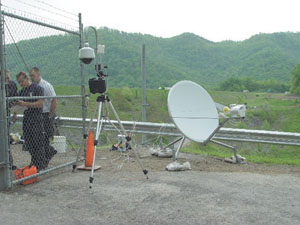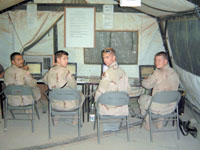Transportable Gear Provides High-Bandwidth Links
 |
| Portable satellite communications products are being used by a number of U.S. government customers such as the U.S. Naval Criminal Investigative Service. The agency used Tachyon Network’s equipment to stream live video to its Washington, D.C., headquarters. |
U.S. government personnel and emergency responders are using commercial mobile satellite communications systems to maintain connectivity in areas with little or no terrestrial infrastructure. Users can set up and activate equipment rapidly, and proprietary protocols allow systems to accelerate the transmission and reception of data, imagery and streaming video.
This connectivity is a vital resource for disaster recovery teams and soldiers operating in undeveloped or devastated zones. Although the military maintains specialized portable satellite telecommunications equipment, several commercial systems now offer many features that government users require, such as strong encryption and high data rates.
Deployable systems provided by Tachyon Networks Incorporated, Vienna, Virginia, are designed for use by government customers in remote locations and as disaster recovery backup systems. These include the company’s T-Force satellite broadband optimizer and customer premise equipment (CPE), offers David Dague, the company’s executive vice president of marketing.
T-Force provides terrestrial performance and packet delivery and complies with transmission control protocol/Internet protocol (TCP/IP) standards. It also offers accelerated Internet protocol virtual private network secure data transport and quality of service. Another product, IPTransport, functions as an open-standards-compliant static router to customers’ local area networks (LANs) and integrates with existing network infrastructures.
For government customers in disaster recovery operations, Tachyon developed the Auto Deploy CPE system to provide broadband connectivity from remote locations. The equipment features push-button antenna deployment that automatically locates the correct satellite and locks onto the company’s high-speed broadband satellite network. Dague notes that Tachyon’s systems are in use with a number of U.S. government and international clients such as the U.S. Navy, U.S. Army, Federal Emergency Management Agency, Department of Homeland Security and the U.K. Ministry of Defence.
The U.S. Naval Criminal Investigative Service (NCIS), Washington, D.C., is using Tachyon satellite communications equipment for its field teams. As the Navy’s main law enforcement and counterintelligence arm, the service needs to set up operations centers quickly at crisis scenes around the world. According to E. Wayne Rose, an NCIS information technology specialist, the group has used Tachyon systems on operational deployments and in simulated disaster exercises.
In May 2003, the NCIS field office major case response team staged a mock car bombing at the Center for National Response, a counterterrorism training facility in West Virginia. The scenario required the team to comb through the debris of a simulated explosion in a roadway tunnel.
Two IP video cameras were set up at the scene. They were connected to a video server and a Tachyon Quick Deploy LAN and satellite dish, allowing the NCIS team to send real-time streaming video to the agency’s Washington office. The system sends video data to the CPE via commercial Ku-band satellite transponders. As a remote connection to Tachyon’s high-speed network, the hardware comprises a satellite dish with integrated transmit/receive electronics, a modem, server computers and data networking equipment. The gateway uses standard protocol and hardware to achieve end-to-end transparency and compatibility. From the gateway, data is then sent to the customer’s LAN.
Rose explains that the system initially was used to transmit images from an emergency site to the organization’s management facilities. The agency has now expanded this capability to include data and voice communications and Internet access. He adds that a two-person team can easily deploy the equipment. “Regardless of where the challenges are, whether in or out of the United States, this particular tool was able to help us meet our mission goals and communicate information in a real-time environment,” he says.
Coalition forces in Iraq also are using the company’s systems. One of the first deployments in the region was as a morale, recreation and welfare package with the U.S. Army’s 11th Aviation Regiment based 60 miles north of Baghdad. According to Master Sgt. Kelly Grafton, USA, the Tachyon equipment was installed shortly after his unit moved into the area in late April 2003.
The master sergeant set up and maintained an Internet café for the regiment’s troops. Because it is a commercial system, it was used only for personal e-mail, Internet Web browsing and videoconferencing traffic. “It was great, to tell the truth. The morale in the unit jumped up 200 percent,” he says.
The Tachyon equipment came in two ruggedized cases that could be set up within 30 minutes. Master Sgt. Grafton also was able to call a Tachyon support center and download software that helped him quickly locate the azimuth and elevation of the nearest satellite. “We never really lost the signal the whole time we had it up, from April [2003] to the following January,” he maintains.
The system featured a small satellite dish attached to a heavy steel frame that was staked into the ground and weighted with sandbags. These measures were important because the desert winds in the region can reach speeds of up to 60 miles per hour. The master sergeant added that little maintenance was needed beyond occasionally cleaning sand and dust off of the dish.
Once the café was established, the equipment had enough bandwidth to support users’ e-mail correspondence, Internet browsing and Web-camera imagery. The system transmits data at a rate of 512 kilobytes per second to the uplink and receives at 2 megabytes per second from the satellite. The master sergeant notes that it supported 25 to 35 users at any given time with daily use exceeding 250 people connecting through the café and other terminals throughout the regiment’s tactical operations center.
 |
| Coalition forces in Iraq are using Tachyon equipment comprising a satellite dish, computers and support hardware and software. The equipment allows troops to send e-mail to their families, browse the Internet and participate in videoconferences. |
Besides hardware, Dague notes that Tachyon also offers network service and support. “We lease the space from commercial satellites across our footprint. So we really run the ground network. We’re the last-mile solution from terrestrial broadband to remote sites,” he says.
The company has moved into the terrestrial backup services market for disaster recovery. Because of the concern for homeland security among its government and commercial clients, the firm’s satellite communications capabilities also are used to maintain connectivity in the event of an infrastructure failure. The equipment can operate on the Ku, C and L satellite bands.
Dague explains that the company built its technology to provide high-fidelity satellite links to transmit IP traffic. This is important because TCP/IP systems often experience transmission difficulties on satellite links, which can be noisy environments because of atmospheric interference. Because TCP/IP is designed for terrestrial use, noise and bit errors activate mechanisms in the protocol designed to get packets to their destination. While this is a useful feature in a fiber optic system, it slows data transmissions across a satellite link. To combat this effect, company engineers designed a link that identifies and corrects bit errors to prevent the TCP congestion control mechanisms from slowing down the network.
The company also developed a proprietary waveform for dynamic power control. If Tachyon’s network operations center detects adverse weather at a downlink, engineers can increase the transmission power to get a signal through. “There may be bit errors dropped, but the link is actually wide open from a capacity perspective,” Dague says.
TCP/IP packets also experience latency problems in a space-based environment because of the time it takes a transmission to reach a receiver. When a delay is encountered, the protocol activates congestion control mechanisms to ensure that packets are getting through. But Dague explains that this system, designed for use on fiber optic networks, slows down transmissions via satellite link and can lead to delays of up to three seconds. “On the remote end, what will typically happen is that TCP will say that a link is not working, or the data comes crawling through so slowly that it’s really not very useful,” he says.
To avoid this problem, satellite network providers have traditionally resorted to a process called “TCP spoofing.” Instead of using this method, Tachyon developed a proprietary Internet protocol to send messages over a link without delays. “Because we know the speed of the link, and we know the quality of the link, the message is sent over to the remote site and is translated back into TCP/IP for the remote user’s consumption,” he says.
Latency and noise also cause delays with encrypted packets traveling over very small aperture terminal links. The company developed a secure traffic acceleration process to bring files and packets up to terrestrial transmission speeds. Dague notes that most systems translate encrypted messages to fit their network protocols, but Tachyon’s method does not require the coded information to be formatted. “All you do is hand us the message. We apply some acceleration technologies to it and fire it off. We don’t touch it at all from an encryption perspective—it’s end-to-end encrypted,” he offers.
Additional information on Tachyon Networks is available on the World Wide Web at http://www.tachyon.net.




Comments